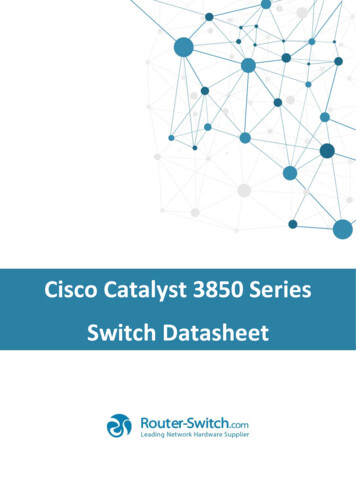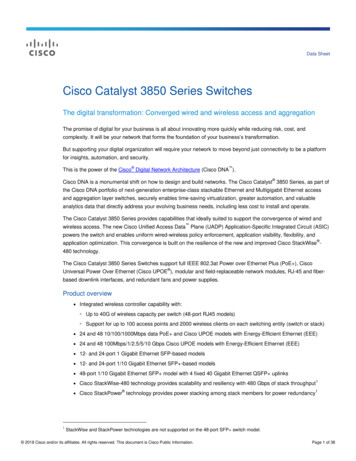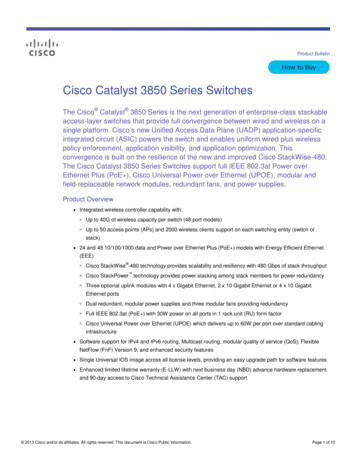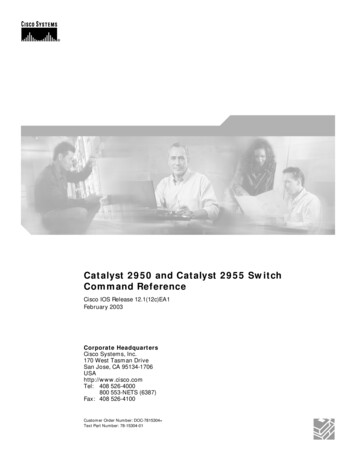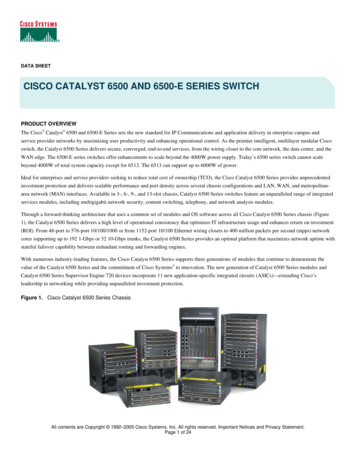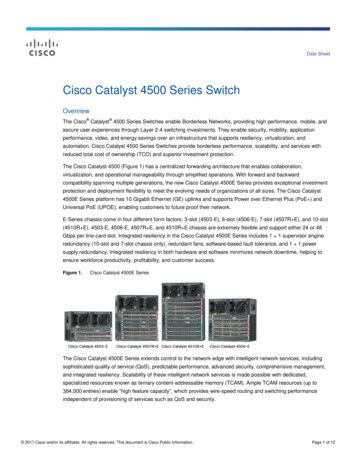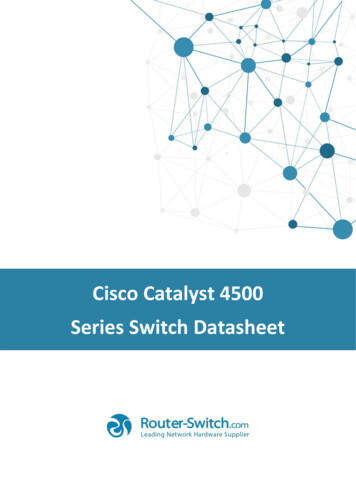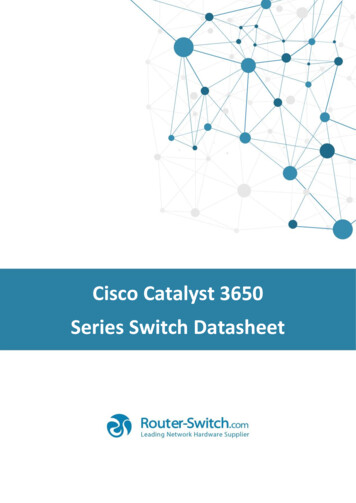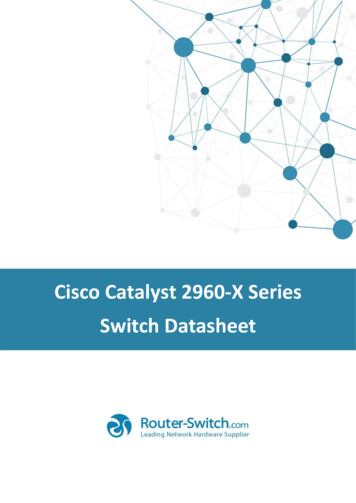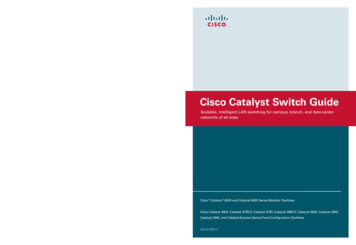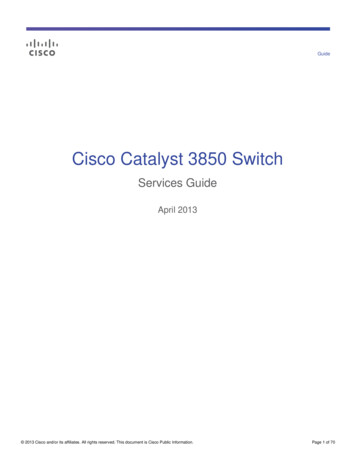
Transcription
GuideCisco Catalyst 3850 SwitchServices GuideApril 2013 2013 Cisco and/or its affiliates. All rights reserved. This document is Cisco Public Information.Page 1 of 70
ContentsOverview . 3Cisco Catalyst 3850 Security Policy. 3Configuring 802.1X in Converged Access . 3802.1X Configuration for Wired Users . 5802.1X Configuration for Wireless Users . 6Downloadable Access Control List . 8Access Control List Deployment Considerations . 9Cisco Catalyst 3850 Quality of Service . 10Wired Quality of Service. 10Cisco Catalyst 3850 Trust Behavior . 10Configuring Ingress Quality of Service . 11Egress Quality of Service . 14Wireless Quality of Service . 15Wireless Targets . 15Wireless: Ingress Quality of Service . 16Ingress Marking and Policing on Wireless Client. 16Ingress Policies on WLAN/SSID. 18Wireless: Egress Quality of Service . 19Policy on Access Point/Port . 19Policy on Radio . 21Policy on Service Set Identification . 22Client . 23Flexible NetFlow . 23Cisco Catalyst 3850 NetFlow Architecture (Wired and Wireless) . 24NetFlow Cisco Catalyst 3850 Overview . 24NetFlow Configuration on Cisco Catalyst 3850 Switch . 24Flow Record . 24Exporter/Collector Information . 25Flow Monitor . 25Attaching a Flow Monitor to Supported Port Types . 26Flexible NetFlow Outputs . 27Multicast Overview (Traditional and Converged Multicast) . 30Restrictions of IP Multicast Routing Configuration . 30Configuring Wireless IP Multicast on Cisco Catalyst 3850 . 30Multicast Mode Configuration. 31Multicast Show Commands. 32Converged Access with the Cisco Catalyst 3850 . 37Distributed Functions Enabling Converged Access . 37Logical Hierarchical Groupings of Roles . 38Converged Access Network Design with Cisco Catalyst 3850 . 39Configuring Converged Access with Cisco Catalyst 3850 . 42Roaming in Cisco Unified Wireless Network . 49Understanding Roams in Converged Access . 52Traffic Paths in Converged Access . 54Relevant Outputs for Tracking Client Roams in Converged Access . 55Nontunneled Roam in Converged Access . 64Tunnel Roles in Converged Access . 67Appendix A: Detailed FnF Field Support . 68 2013 Cisco and/or its affiliates. All rights reserved. This document is Cisco Public Information.Page 2 of 70
Overview The Cisco Catalyst 3850 Switch is built on a unified access data plane (UADP) application-specific integratedcircuit (ASIC). This is a state-of-the-art ASIC that has all services fully integrated in the chip and thus requires noadditional modules. The ASIC is programmable and is flexible to support future requirements. It also deliversservices with flexibility and visibility across wired and wireless networks.The access layer of the network has evolved from just pushing the traffic into the network to delivering a plethora ofservices. The convergence of wired and wireless networks adds another level to services being applied at theaccess layer. Service-rich and service-aware networking platforms allow organizations to achieve not only lowertotal cost of ownership (TCO), but also faster time to service delivery.This document provides an overview of the Cisco Catalyst 3850 and the steps to deploy services with the CiscoCatalyst 3850. It broadly includes the following sections: Security Quality of service Flexible NetFlow Multicast MobilityCisco Catalyst 3850 Security PolicyIn today’s networking environment, it has become a challenge to manage security policies on wired and wirelessnetworks. It is mainly due to the fact that wired and wireless users are being identified in different points on thenetwork and are subject to different policies.The Cisco Catalyst 3850 defines a major change in the architecture, because it brings wired and wireless networkstogether on an access switch. As we terminate the wireless users on the Cisco Catalyst 3850, we also get visibilityto users who are getting onto the network at the access layer, similar to wired users. This change also moves thepolicy point to the access layer, and therefore it gets consistent with the wired endpoints.Configuring 802.1X in Converged AccessIn the topology diagram shown in Figure 1, a wired corporate user and access points are connected to the CiscoCatalyst 3850. Two wireless clients are connected to the service set identification (SSID) on the Cisco Catalyst3850. One of the wireless users is a corporate user, and the other user is a partner. Corporate users and partnerusers have different security policies defined on Cisco’s Identity Services Engine (ISE) server that is in the campusservices block. There are other servers such as call manager, video streaming server, and the Cisco Prime Infrastructure server in the campus services block as well. 2013 Cisco and/or its affiliates. All rights reserved. This document is Cisco Public Information.Page 3 of 70
Figure 1.802.1X with Converged AccessThe authentication, authorization, and accounting (AAA) group and RADIUS server are set up on the CiscoCatalyst 3850. The authentication and authorization are redirected to the ISE server. The wireless clients are setup to get authenticated using dot1x.aaa new-modelaaa authentication dot1x CLIENT AUTH group radiusaaa authorization network CLIENT AUTH group radius!The ISE server is the RADIUS server, and the switch is defined on the ISE server as one of the network devices.The RADIUS server needs to be defined on the switch.radius server iseaddress ipv4 9.9.9.9 auth-port 1812 acct-port 1813timeout 60retransmit 3key cisco123! 2013 Cisco and/or its affiliates. All rights reserved. This document is Cisco Public Information.Page 4 of 70
To define the Cisco Catalyst 3850, on the ISE screen, navigate to Administration Network Resources Network Devices as in Figure 2.Figure 2.Device Definition in ISEThe dot1x needs to be enabled on the switch globally for wired and wireless clients.dot1x system-auth-control!802.1X Configuration for Wired Users802.1X for wired users is configured per port. Here is the port configuration:interface GigabitEthernet1/0/13switchport access vlan 12switchport mode accessaccess-session port-control autoaccess-session host-mode single-hostdot1x pae authenticatorservice-policy type control subscriber DOT1XThe Cisco Catalyst 3850 also introduces session-aware networking (SaNet), which is a replacement for Auth Manager that is present in current Cisco IOS Software platforms.The objective of having SaNet is to have no dependency between features applied to sessions or authenticationmethod. Thus, with appropriate AAA interactions, any authentication method should derive authorization data forany feature, to be activated on a session. This can be accomplished by using a policy model similar to ModularPolicy Framework (MPF), which is used in routing protocols, firewall rules, quality of service (QoS), and so on. Formore details, see SaNet documentation at nfiguration/xe3se/3850/san-overview.html. The following policy is an example for SaNet: 2013 Cisco and/or its affiliates. All rights reserved. This document is Cisco Public Information.Page 5 of 70
class-map type control subscriber match-all DOT1X NO RESPmatch method dot1x!policy-map type control subscriber DOT1Xevent session-started match-all1 class always do-until-failure2 authenticate using dot1x retries 3 retry-time 60event authentication-success match-allevent authentication-failure match-all5 class DOT1X NO RESP do-until-failure1 authentication-restart 60!802.1X Configuration for Wireless UsersFor wireless clients, 802.1x is configured under WLAN configuration mode. The AAA authentication method issimilar to wired clients.wlan Predator 1 Predatorsecurity dot1x authentication-list CLIENT AUTHWhen a user provides credentials, the ISE server authenticates and authorizes the user. Upon successfulauthorization, the user is assigned a specific VLAN, which provides policies based on groups or device types inISE. It also provides other policies such as QoS, downloadable access control list (dACL), and so on.The client session is maintained on the Cisco Catalyst 3850 after authorization, until the session is terminated. Theclient states are controlled by the wireless control manager (WCM) process.Any end station (wired or wireless) authenticating using dot1X is termed as a “client,” and all the policies such asdACL and QoS that are specific to this client are installed on the client entity in hardware, unlike ports in theexisting 3K switches. This is one way that consistency between wired and wireless clients is achieved.To look at the overall wired and wireless devices connected on the switch, the following command can be used:Switch#sh access-sessionInterfaceMAC AddressGi1/0/13MethodDomainStatus Fg Session ID0024.7eda.6440 77a3 a1ad dot1xDATAAuth0a01010150f57ac20000002fSession count 3Key to Session Events Status Flags:A - Applying Policy (multi-line status for details)D - Awaiting DeletionF - Final Removal in progress 2013 Cisco and/or its affiliates. All rights reserved. This document is Cisco Public Information.Page 6 of 70
I - Awaiting IIF ID allocationP - Pushed Session (non-transient state)R - Removing User Profile (multi-line status for details)U - Applying User Profile (multi-line status for details)X - Unknown BlockerThe following output shows the detailed view of the wireless client session:Switch#sh access-session mac b065.bdb0.a1ad detailsInterface:IIF-ID:MAC Address:Capwap00xE49A0000000008b065.bdb0.a1adIPv6 Address:UnknownIPv4 Address:12.0.0.2User-Name:Status:Domain:Oper host mode:user1AuthorizedDATAmulti-authOper control dir:bothSession timeout:N/A snip .snip Server Policies (priority 100)ACS ACL:xACSACLx-IP-user1-46a243ebMethod status list:MethodStatedot1xAuthc SuccessThe following is the configuration on the wired port:Switch#sh run int gig1/0/13Building configuration.Current configuration : 317 bytes!interface GigabitEthernet1/0/13description dot1X Wired Port in Vlan 30switchport access vlan 30switchport mode accessload-interval 30access-session host-mode single-hostaccess-session port-control autodot1x pae authenticatorspanning-tree portfastservice-policy type control subscriber 802.1xend 2013 Cisco and/or its affiliates. All rights reserved. This document is Cisco Public Information.Page 7 of 70
The following is the detailed output of the wired client session:Switch#sh access-session mac 0024.7eda.6440 detailsInterface: GigabitEthernet1/0/13IIF-ID: 0x1092DC000000107MAC Address: 0024.7eda.6440IPv6 Address: UnknownIPv4 Address: 10.3.0.113User-Name: corp1Status: AuthorizedDomain: DATAOper host mode: single-hostOper control dir: bothSession timeout: N/ACommon Session ID: 0A010101000011334A316CE0Acct Session ID: UnknownHandle: 0x8B00039FCurrent Policy: 802.1xServer Policies:ACS ACL:xACSACLx-IP-Corp-506f07b4Method status list:Methoddot1xStateAuthc SuccessNote:In the preceding output, the ACL is installed on the client entity and not on the port.Downloadable Access Control ListThe screenshot in Figure 3 shows the dACL definition in ISE.Figure 3.Downloadable ACL Screen 2013 Cisco and/or its affiliates. All rights reserved. This document is Cisco Public Information.Page 8 of 70
After defining ACL in ISE, it can be associated with an authorization profile, as shown in Figure 4.Figure 4.Note:Authorization ProfileIf a named authentication method-list is in place for AAA, an attribute needs to be set from ISE, asshown in 4 Method-List in this example is CLIENT AUTH.After successful download of ACL, the client is authorized, and the following is the output of ACL:Switch#sh access-listsExtended IP access list xACSACLx-IP-user1-46a243eb (per-user)1 permit udp any any eq domain2 permit tcp any any eq domain3 permit udp any eq bootps any4 permit udp any any eq bootpc5 permit udp any eq bootpc any6 permit ip any anyAccess Control List Deployment ConsiderationsWith the Cisco Catalyst 3850 and converged access, ACLs can now be applied to wireless clients as they areapplied on wired ports/clients. The Cisco Catalyst 3850 has more ternary content-addressable memory (TCAM)space assigned for ACLs than 3K-X switches. The following paragraphs describe some of the scalability numbers.Table 1 summarizes the access control entries (ACEs) scalability.Table 1.Scale NumbersACL ResourcesCisco Catalyst 3850IPv4 ACE3000 entriesIPv6 ACE1500 entriesL4OPs/ACL8 L4OPs 2013 Cisco and/or its affiliates. All rights reserved. This document is Cisco Public Information.Page 9 of 70
The total capacity of the ACEs is an aggregate number that constitutes all types of ACEs. One type of ACE,however, can scale up to 1500. For example, the total number of Port ACL (PACL) access control entries cannotexceed 1500. But a combination of PACL and Router ACL (RACL) access control entries can scale up to 3000.Cisco Catalyst 3850 Quality of ServiceOne of the primary advantages of the Cisco Catalyst 3850 is the visibility into wireless packets at the access layer.This visibility is a powerful feature and enables network administrators to apply the rich intelligent services of wiredtraffic and extend these services to wireless traffic as well. QoS is one of the features that can be applied onwireless traffic similar to that of being applied on wired network.Significant QoS features have been introduced for wired as well as wireless on the Cisco Catalyst 3850. Some ofthem are the following and are discussed in detail later in the document: Modular QoS CLI (MQC) Approximate Fair-Drop (AFD) algorithm for bandwidth management across wireless users, providinghierarchical support across access points, radios, Basic Service Set Identifier (BSSID), and clients. Eight queues per port (wired) and 4 queues per port (wireless) Bidirectional policing support in hardware for wireless clients Two-level hierarchical QoS on wired ports Per-SSID bandwidth management; differentiated bandwidth management across SSIDsBecause of the inherent differences of wired and wireless media and transmission methods, there are differencesbetween wired and wireless QoS.Wired QoS on the Cisco Catalyst 3850 is explained later, followed by wireless QoS in the following section.Wired Quality of ServiceCisco Catalyst 3850 Trust BehaviorThe trust behavior on the Cisco Catalyst 3850 has changed from the that of Cisco Catalyst 3K Series switches. Bydefault, the Cisco Catalyst 3850 trusts markings on the wired ports. For wired ports, differentiated services codepoint (DSCP) markings in IP packets from endpoints such as IP phones, telepresence units, cameras, and laptopsare
The Cisco Catalyst 3850 Switch is built on a unified access data plane (UADP) application-specific integrated circuit (ASIC). This is a state-of-the-art ASIC that
